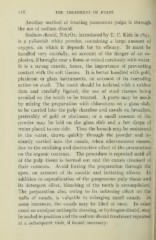Page 250 - My FlipBook
P. 250
2l8 THE TREATMENT OF PULPS
Another method of treating putrescent pulps is through
the use of sodium dioxid.
Sodium dioxid, NA2O2, introduced by E. C. Kirk in 1893,
is a yellowish white powder, containing a large amount of
oxygen, on which it depends for its efhcacy. It must be
handled very carefully, on account of the danger of an ex-
plosion, if brought near a flame or mixed carelessly with water.
It is a strong caustic, hence, the importance of preventing
contact with the soft tissues. It is better handled with gold,
platinum or glass instruments, on account of its corroding
action on steel. The tooth should be isolated with a rubber
dam and carefully ligated, the use of steel clamps being
avoided on the tooth to be treated. A paste may be made
by mixing the preparation with chloroform on a glass slab,
to be carried into the pulp chamber and canals on broaches,
preferably of gold or platinum; or a small amount of the
powder may be laid on the glass slab and a few drops of
water placed to one side. Then the broach may be moistened
in the water, drawn quickly through the powder and in-
stantly carried into the canals, when effervescence ensues,
due to the oxidizing and destructive effect of the preparation
on the organic contents. The procedure is repeated until all
of the pulp tissue is burned out and the canals cleansed of
their contents. Avoid forcing the preparation through the
apex, on account of its caustic and irritating effects. In
addition to saponification of the gangrenous pulp tissue and
its detergent effect, bleaching of the tooth is accomplished.
The preparation also, owing to its softening effect on the
walls of canals, is valuable in enlarging small canals. In
some instances, the canals may be filled at once. In other
cases an anodyne antiseptic dressing, or hydrogen-dioxid, may
be sealed in position and the sodium dioxid treatment repeated
at a subsequent visit, if found necessary.


